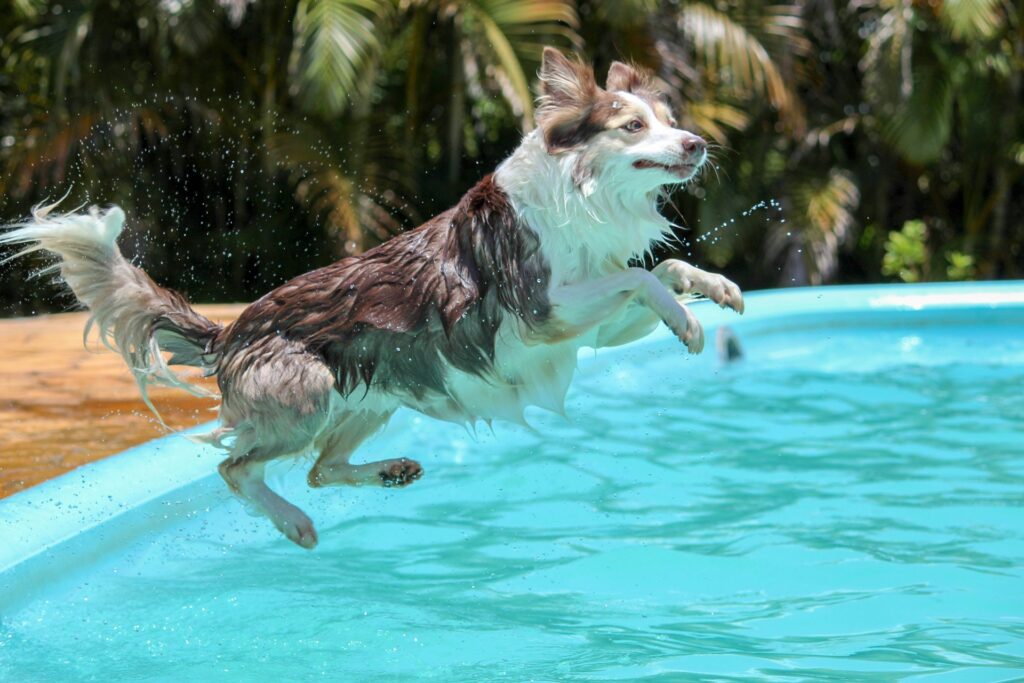Learn about Can Dogs Swim in Saltwater Pools. Learn if dogs can swim in saltwater pools safely. Explore benefits, risks, precautions, and expert tips to keep your pup happy and healthy.
What Is a Saltwater Pool?
The saltwater swimming pool operates using a saltwater chlorine generator, minimizing irritability by those accustomed to chlorine pools. The salt amount in freshwater pools hardly compares with that found in oceans. This inhibits skin-water interaction from drying any species’ skin.
Can Dogs Swim in Saltwater Pools?
Yes, dogs can use saltwater pools. These pools are much easier on their coats and skin compared to chlorine pools. Still, supervision is essential; dogs should never be allowed to drink pool water. Rinse them off after swimming to avoid irritation, and maintain the pools well for their safety and that of your equipment.
Considerations for Letting Dogs Swim in Saltwater Pools
1. Salt Ingestion
It is safe for your dog if they ever ingest a tiny amount of pool water. The salt you eat could cause you to become sick with salt poisoning or hypernatremia. Symptoms are decreased activity, vomiting, and diarrhea. Pets must be watched at all times, and providing them fresh drinking water prevents them from drinking from the pool.
2. Skin and Fur Reactions
Occasionally, dogs with delicate skin may get inflamed no matter how friendly the saltwater pool is. When your dog finishes swimming, wash its fur with pure water to wash off salty buildup, which will relieve you of the issues.
3. Ear Infections
Ear infections can be common in dogs, particularly those with floppy ear types like Golden Retrievers or Cocker Spaniels, following a swim. Always dry their ears well after swimming, in order to prevent a moist atmosphere.
4. Nail and Paw Pad Damage
Swimming pool liners and steps may have scratches from a dog’s nails, and exposure to salt might irritate their paw pads. Check your dog’s nails and watch for signs it is uncomfortable, then consider trimming them.

5. Pool Maintenance
The dirt and hair they bring into the pool from, say, jumping on the poolside, can cause your filters to work harder and increase cleaning tasks. Keep a quality skimmer and pay attention to the upkeep of your filter system.
Benefits of Saltwater Pools for Dogs
1. Gentler on Skin and Fur
With precious few exceptions, swimming in a saltwater pool will soothe a dog’s skin much more pleasantly than in a standard chlorine pool, which can sap moisture from its coat. This is just another reason folks with allergies or sensitive skin choose to acquire hypoallergenic animals.
2. Reduced Chemical Exposure
Less harsh chemicals are used in saltwater pools. Dogs usually avoid red eyes, skin irritation, and respiratory problems that may happen to swimmers after using a standard chlorinated pool.
3. Better for Joint Health
Swimming is a great, gentle form of physical activity for dogs. It aids joints, mainly in older dogs and those that are likely to develop hip dysplasia. Swimming in saltwater pools is great for those who want to exercise gently.
Risks and Precautions
1. Ingesting Too Much Saltwater
Designed with lower salinity than ocean waters, drinking excessive pool water can cause salt poisoning (hypernatremia) as much as it would drinking saltwater from the ocean. The classical signs of salt poisoning are vomiting, diarrhea, lethargy, and seizures. Ensure that fresh drinking water is supplied at the poolside to deter drinking from it.
2. Ear Infections
Frequent swimming can impose a higher threat of ear infection among the floppy-eared breeds. Dry the ears of your dog thoroughly after every swim and use a vet-approved ear cleaner regularly.
3. Paw and Nail Wear
Long-term exposure to saltwater might make paw pads dry or cause problems with your pet’s nails. Wash your dog’s paws with water and then use any suitable moisturizer if required.
4. Filter System Concerns
The shedding dogs will block the filters in the swimming pool. For heavily shedding dogs, brush before swimming, and keep checking your filter for regular maintenance.
How to Safely Introduce Your Dog to a Saltwater Pool
Step 1: Supervise Always
Never leave your dog alone in a swimming pool. Not every dog can swim; some may panic or quickly, even if the water is very shallow.
Step 2: Use Dog-Friendly Entry Points
Install dog-safe ramps or adopt shallow steps to ease access. This greatly lessens the tension and allows your dog to get in and out injury-free.
Step 3: Rinse After Swimming
Wash your dog’s hair with clean water after swimming to get rid of salt and stop the skin from becoming dry or irritated.
Step 4: Monitor for Signs of Distress
Symptoms you should watch for in your pets are coughing, constant tiredness, increased panting, and vomiting. It could show that the animal took in salt or overheated somehow.
Step 5: Use Pool Alarms or Life Vests
If your dog does not love the water or hasn’t swum a lot, getting a canine life vest will give him more security.
Tips for Swimming Safely with Your Dog in a Saltwater Pool
- Be vigilant on the swimming sessions with your dog so they won’t drink much water or strain themselves a bit too much.
- Place fresh drinking water nearby to prevent them from drinking from the pool.
- Wash off the salt and prevent dry skin after swimming.
- Train your dog to go up and down a ramp or steps where it can safely enter and exit.
- Limit swimming periods to decrease exposure and fatigue.
4 Advantages of a Saltwater Pool
1. Saltwater Pools Are Gentler on Your Body and Clothing
Swimming in saltwater pools does not cause much irritation to your eyes and skin. They take the pressure off swimsuits, so fabric dyes and elasticity last longer.
2. There Is No Harsh Chlorine Smell
It only means gradual release of chlorine in saltwater pools; thus, this enables the water to remain free from that overwhelming chemical smell, making swimming a more fun activity without the strong chlorine smell of the traditional pools.
3. The Water Is Softer
The water in saltwater pools is much more silky and softer than that found in chlorinated pools. For this reason, swimming for many swimmers is preferred since they feel it soothes the part that is much better for everyday life.
4. You Don’t Need to Store Chlorine
You don’t need to get chlorine chemicals since saltwater systems produce it automatically, so there is no need to buy, use, or store chlorine. As a result, maintaining products is much simpler and safer, and the use of harsh chemicals at home is decreased.

Cons of saltwater pools
They Have a Higher Initial Cost
You have to put a salt chlorine generator in a saltwater pool, which can be quite costly. However, the costs of installing and setting up a saltwater pool are always higher, yet this can be offset by less frequent chemical use.
Salt Can Damage Some Types of Tiles
Soft stones, metal fittings, and grout can be damaged by salt. If a pool is not sealed, exposure to saltwater can gradually wear down the pool and the area around it.
Repairs Can Only Be Done by a Professional
You have to contact us to use a salt chlorine generator because these systems require a specific type of know-how due to their complexity. It is not advised to fix an AC by yourself. Any problems generally require a pr, and this can lead to higher costs for maintenance.
Conclusion
Being in a saltwater pool means lower risk for you and your pet. By watching over them, providing care, and maintaining their needs, dogs can swim safely. Rinse them off after they swim, watch for signs of trouble, and take care of pool hygiene all the time.
